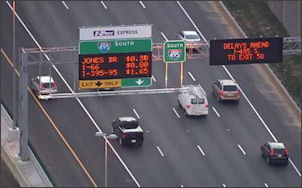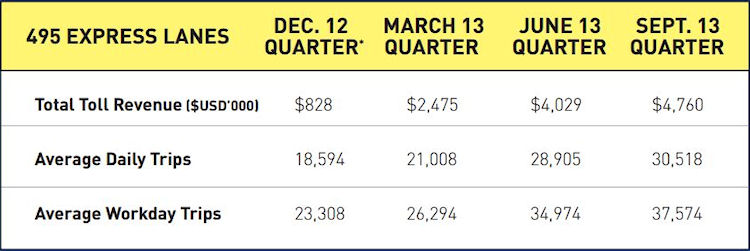Traffic and revenues on Northern Virginia’s 495 Express Lanes increased steadily in 2013, generating a record 47,000 trips and toll revenue of $124,000 on December 19, according to data the company released yesterday. Whether that’s enough to meet expectations of parent company Transurban Holdings Ltd., headquartered in Australia, or to encourage additional private investment in Virginia’s transportation infrastructure, however, remains an open question.
At the end June 2013, Transurban stated in its annual report that the first half year’s traffic performance “has been lower than expected, but has continued to grow.” At that time the company said it was too early to determine any reliable traffic trends. The latest publication indicates that traffic volumes and average tolls have increased since then, even though 4th quarter results were hampered by the federal government shutdown. Of special note, revenues rose markedly, from $3.3 million in the first half of the year to $8.8 million the second half.
Here’s Transurban’s problem: When it was lining up financing in 2007 for the $2 billion project, which added four new lanes to a 14-mile stretch of the Capital Beltway, the economy was booming. A 2007 traffic and revenue study by Vollmer/Stantec forecast average weekday trips over the first full year of operations at 66,000 and revenue of $46.1 million, according to Toll Road News. After four years of operation, the study forecast, the express lanes would log 117,000 average weekday trips and annual revenue of $79 million. No one anticipated the severe recession or the national erosion in Vehicle Miles Traveled that eased congestion on the nation’s highways. The whole point of paying a toll to use the express lanes is to avoid the unpredictability and time delays caused by congestion. No congestion = no revenue.
The company pulled out of its investment in the Pocahontas Parkway outside Richmond last year but remains committed to completing the Interstate 95 express lanes project in Northern Virginia.
Bacon’s bottom line: For supporters of market-based and fiscally conservative solutions to Virginia’s transportation challenges, the 495 Express Lanes are a vital test. Failure would cast a shadow over future private investments in Virginia transportation infrastructure, and the state could return to Business As Usual practice of blindly building highway projects with no accountability for results.
The express-lanes concept is appealing for several reasons. First, the private sector raised most of the money to pay for the expansion of Interstate 495 capacity — money the state did not have — and assumed the financial risk should traffic and revenues prove disappointing. Given the shortfall in ridership and revenues, Virginians should be darn grateful that Transurban, not the commonwealth of Virginia, is taking on that risk. Transurban shareholders, not Virginia taxpayers, will take the hit if the shortfall persists.
Second, the express lanes use price as a rationing mechanism for scarce highway capacity. Those who place the greatest value on their time — to get to a business meeting, say, or to pick up a child from day care — can pay a premium to bypass the congestion and save themselves time. As it turns out, 84% of riders surveyed — yes, Transurban actually surveys its customers; take a hint VDOT — cited predictable travel times as one of their “favorite things” about the lanes. Sixty-eight percent said they use the lanes to “reach a destination on time.”
The logic of paying to avoid congestion is the antithesis of the all-too-common sentiment that roads should be “free” and that the state has an obligation to spend whatever it takes to keep those roads free-flowing — all with the expectation, of course, that “someone else” should pay. It is an axiom of economics that when a good is free, consumers will use far more of it than if they had to pay for it. In the case of roads, excess demand creates pressure to create excess supply. Express Lanes avoid that trap — if motorists want free-flowing conditions during period of peak traffic, they pay for the privilege. If they are unwilling to pay, it’s a clear indication that they place trivial value on reducing their travel time.
Third, requiring road projects to cover their own costs is a mechanism for weeding out uneconomic projects, whether funded by private or public dollars. One good thing about 495 Express Lanes is that the public gets a regular accounting of traffic volumes, toll prices and revenue. (It would be nice if we got a cash flow analysis, too.) The project creates information about the economic viability of highway projects that we could not obtain otherwise. We get no such information from non-tolled projects, whose costs are buried within Virginia Department of Transportation budgets. We have no way to judge whether public investments in non-tolled projects such as Rt. 288 or the Interstate 295 circumferential highways around Richmond, to pick an example, were wise or foolish.
I regard the 495 Express Lanes as a template for transportation policy across Virginia. I would like to see it succeed financially because I’d like to see companies like Transurban propose more market-based solutions to Interstate congestion, not just in Northern Virginia but for congested stretches of Interstate 81 in western Virginia, Interstate 95 around Richmond and Interstate 64 in Hampton Roads. If the 495 Express Lanes project proves financially disappointing, I fear, the state will default to funding highway projects based upon political considerations with no mechanism to hold the decision-makers accountable. The end result will be construction of projects with weak economic justification and the squandering of billions of public dollars.




